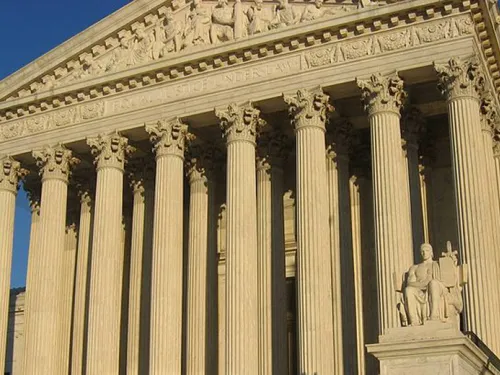On October 6, 1973, Egypt and Syria attacked Israel in an effort to force Israel to surrender the land gained in the 1967 Six Day War. The attack was on the holiest day of the Jewish calendar, Yom Kippur. Caught by surprise, in the war's initial days, Israel suffered severe losses of life, military equipment, and territory, abruptly shattering the euphoria the country had experienced since its show of strength six years earlier. Following an Egyptian refusal to accept a cease-fire and a Soviet…
448 Results
The Green Line is a term used to delineate the demarcation line between Israel, Jordan, Egypt and Syria from the period following Israel’s 1948 Independence War until the 1967 Six Day War when Israel captured the West Bank, and East Jerusalem from Jordan, the Gaza Strip from Egypt, and the Golan Heights from Syria. It is reportedly named for the green pen used by officers negotiating the armistice in 1949 to delineate the borders between the countries.
Today, the Green Line refers to…
In May 1967, growing tensions in region led Israel to expect that a potentially destructive catastrophic Arab attack was imminent.
Egyptian President Gamal Abdel Nasser ordered a withdrawal of the U.N. Emergency Forces in the Sinai Peninsula and began amassing massive armies along Israel’s Southern border. On May 22, Nasser announced a blockade of Israeli goods through the Straits of Tiran — the narrow maritime passage through which Israeli shipping accessed international…
The Arab Economic Boycott was initiated in 1946 by the newly formed League of Arab States. The boycott was aimed at preventing the continued growth of the Jewish community in Mandate-era Palestine by boycotting the goods and services produced by Jewish businesses. After Israel’s establishment in 1948, the Arab League used the expanded boycott as another form of warfare against the state in an effort to undermine Israel’s economic viability.
The Arab boycott operated on several…
On May 15, the day after the establishment of the State of Israel, the Arab armies of Egypt, Syria, Jordan, Iraq, and Lebanon invaded the new state (Saudi Arabian forces fought with Egypt). While Arab forces were significantly larger and better equipped than Israel’s, coordination and organization within the Arab armies was lacking and political squabbles over conquered territories strained relations among the Arab allies. Despite its small number, the Israeli army was well-organized,…
The Israel-Egypt peace agreement was a watershed event, marking the first such agreement between the Jewish state and an Arab state. The breakthrough came in November 1977 when Egyptian President Anwar Sadat made a bold and unprecedented visit to Israel, and in a speech at the Israeli Knesset (parliament), addressed the Israeli people with a call for reconciliation and peace.
Formal negotiations ensued the following September when Sadat and Israeli Prime Minister Menachem Begin joined U.S…
United Nations Security Council Resolutions 242 and 338 were passed (respectively) in the aftermaths of the 1967 and 1973 Arab-Israeli wars.
Resolution 242 (reaffirmed in 338) was designed to provide the framework for peace negotiations based on a “land-for-peace” formula and has become the foundation of all subsequent negotiations and peace treaties in the region.
The resolutions called for the withdrawal of Israeli forces “from territories of recent conflict,”…
In response to unceasing missile, rocket and mortar fire on civilian centers in Israel, on July 7, 2014, Israel launched a military operation, codenamed “Operation Protective Edge.” Israel Defense Forces (IDF) targeted strategic Hamas facilities, tunnels, weapons and leadership. The conflict lasted 50 days, with a series of short-lived ceasefires breached by Hamas. Israel initially attacked Hamas targets by air, however, on July 17, Israel sent ground forces into Gaza for a…
Palestinian Islamic Jihad (PIJ) is a radical Islamic extremist organization inspired by the Iranian revolution of 1979. It was established by Palestinian students in Egypt who were admirers of the Iranian Revolution and the Muslim Brotherhood. Like Hamas, its expressed goal is the violent destruction of the State of Israel, which Islamic Jihad believes will then bring about the unification of the Arab and Islamic world, “purified of modern Western elements.”
The PIJ carried out…
The PLO was founded in 1964 during the first Arab summit in Cairo, where leaders of 13 Arab nations pledged to take a more active role for the “liberation of Palestine.” Since that time it has declared itself the representative of the Palestinian people and their nationalist aspirations. The PLO has operated primarily as an umbrella organization for six Palestinian groups, most prominently, Yasser Arafat’s Fatah group. In 1969, Arafat was elected PLO Chairman, and Fatah…
The Palestinian Authority (PA) is the body which governs and administers Palestinian areas in the West Bank. It was established as a result of the 1993 Oslo Agreement between Israel and the PLO, and came into being in 1994, overseeing Palestinian population centers in the West Bank and Gaza Strip. However, since the 2007 Hamas takeover of Gaza, the PA no longer governs the Gaza Strip. The PA President effectively serves as the representative of the Palestinian people in the international…
The territory known as the West Bank is the area to the west of the Jordan River. It is approximately 2262 square miles in total area, and is home to approximately 2.7 million Palestinians and approximately 400,000 Israeli Jews living in settlements.
The West Bank formed the heart of ancient Israel and was the site of many significant biblical events. Since ancient times, the area has been known as Judea and Samaria and was identified as such through the British Mandate period. From…
On May 31, 2010, after numerous warnings, IDF naval forces intercepted six ships en route to Gaza which intended to break the Israeli blockade of Hamas-controlled Gaza. The flotilla was sponsored by the Free Gaza Movement (FGM), several European Palestinian solidarity organizations and Insani Yardim Vakfi (IHH), an Istanbul-based Islamic charity with ties to Hamas. During the operation, flotilla members on one ship, the Mavi Mamara, violently attacked the IDF personnel with weapons…
In response to intensifying rocket attacks from Gaza, on November 14, 2012 Israel launched an aerial military operation in Gaza, code named Operation Pillar of Defense, targeting Hamas and Islamic Jihad terrorist leadership and rocket launching and storage sites. A ceasefire, facilitated by Egypt and the United States, was reached on November 21.
On the first day of the operation, an Israeli airstrike killed Hamas military chief Ahmed Jabari, who Israeli security sources say was…
Settlements are Jewish communities established in the West Bank and Gaza Strip after these territories came under Israel’s control at the end of the 1967 War.
In the 1970s, successive Israeli governments believed that settlements in certain sections of the West Bank, particularly in the Jordan Valley and eastern slopes of Samaria, as well as in areas of the Gaza Strip, would provide Israel with an important military buffer zone. Settlement expansion was also spurred by activists …
On December 27, 2008, in response to eight years of barrages of rockets and missiles launched by Hamas and other terrorist organizations in Gaza, Israel began a ground military operation. In light of the unceasing attacks, Israel felt it had no choice but to act against Hamas and eliminate its operational capabilities.
As then Presidential candidate Barack Obama said in July 2008 when he visited the beleaguered southern town of Sderot – the target of thousands of rockets - "If…
The Palestinian refugee issue originated in the 1948 Arab-Israeli war, when five Arab armies invaded the State of Israel just hours after it was established. During the ensuing war, as many as 750,000 Palestinian Arabs fled their homes in the newly created state as a result of many factors. Some of the Palestinian Arabs who fled did so to avoid the ongoing war or at the urging of Arab leaders, and expected to return after a quick and certain Arab victory over the new Jewish state. Other…
Jerusalem is Judaism’s holiest city, and is also holy to Christianity and Islam.
The Jewish people are inextricably bound to the city of Jerusalem and it has a dominant role in the history, politics, culture, religion, national life and consciousness of Jewry and Judaism. From the time King David established the city as the capital of the Jewish state, circa 1000 BCE, and his son Solomon built the Temple on the site where Abraham nearly sacrificed Isaac, it has served as the symbol…
The so-called “Second Lebanon War” between Israel and the Lebanon-based Hezbollah was sparked by Hezbollah’s July 12, 2006, cross border raid from Lebanon into Israel. Hezbollah attacked a group of Israeli soldiers patrolling the border, killing eight soldiers and kidnapping two others — Ehud Goldwasser and Eldad Regev. Israel responded with precision air strikes specifically aimed at Hezbollah positions and operational assets inside Lebanon; Hezbollah immediately…
The Arab Peace Initiative is a comprehensive peace plan which was proposed in 2002 by then-Crown Prince Abdullah of Saudi Arabia. The Initiative calls for an end to the conflict between Israel and the Palestinians and the normalization of relations between Israel and the entire Arab world, in exchange for an Israeli withdrawal from the areas gained by Israel during the 1967 Six Day War and a “just settlement” to the issue of Palestinian refugees. The Arab League endorsed the plan…









